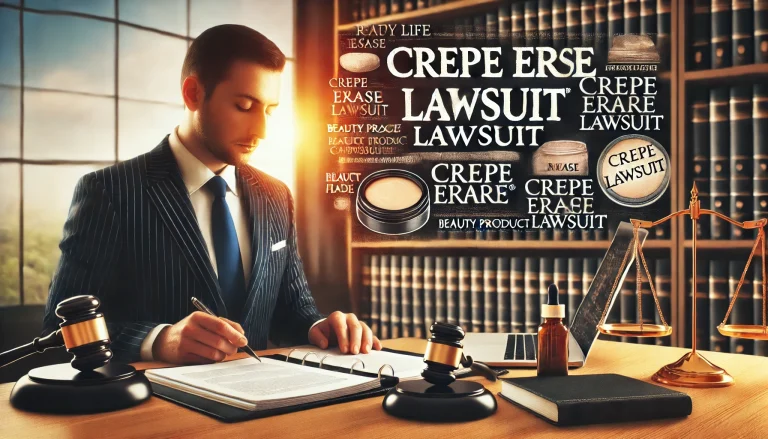Introduction to Crepe Erase and the Lawsuit
Overview of Crepe Erase:
Crepe Erase is a popular skincare product designed to reduce the appearance of crepey skin, which is thin, wrinkled skin often caused by aging. The product claims to tighten, firm, and rejuvenate the skin, promoting a younger look by using its signature ingredient, TruFirm Complex, made from plant-based extracts.
Introduction to the Lawsuit:
The Crepe Erase lawsuit centers on accusations of false advertising and product ineffectiveness. Customers have filed complaints that the product did not deliver the promised results, with many alleging that the brand overstated its ability to reduce wrinkles and smooth skin.
Key Allegations in the Crepe Erase Lawsuit
False Advertising Claims:
The Crepe Erase lawsuit includes accusations that the brand made misleading claims about the effectiveness of its products. Customers allege that the company overstated its anti-aging benefits, promising noticeable reductions in wrinkles and crepey skin that many users did not experience. These claims are seen as deceptive, particularly to consumers looking for effective skincare solutions.
Product Safety and Side Effects:
Another major complaint in the lawsuit revolves around product safety. Several consumers reported experiencing skin irritation and other adverse reactions after using the products. These side effects were not clearly disclosed, leading to concerns about the brand’s transparency regarding potential risks of using Crepe Erase.
Legal Proceedings and Updates
Timeline of the Lawsuit:
The Crepe Erase lawsuit was filed after numerous customer complaints about misleading advertising and product effectiveness. The legal process began with initial court hearings, where the company defended its marketing strategies and product claims. Key dates include the formal filing of the lawsuit, followed by pre-trial motions and discovery phases where both sides gathered evidence.
Current Status:
As of now, the case remains ongoing, with the court continuing to review the claims presented by both sides. The company maintains its defense, stating that Crepe Erase meets industry standards and that individual results may vary, while plaintiffs seek compensation for false claims and undisclosed side effects. The court’s final decision could potentially lead to refunds or further regulatory actions.
Consumer Complaints and Reactions
Dissatisfaction with Results:
Many consumers who used Crepe Erase reported disappointment due to the lack of visible improvement in skin texture. They felt the product did not deliver on the anti-aging benefits that were heavily promoted. Some users claimed the product made little to no difference, leaving them frustrated.
Common Issues Raised by Consumers:
Apart from ineffectiveness, users frequently voiced concerns about skin irritation after applying the product, which was not clearly disclosed in the marketing. Additionally, complaints about the subscription model were common, with customers expressing dissatisfaction over the difficulty in canceling subscriptions and receiving unwanted product shipments.
Company’s Response to the Lawsuit
Denial of Wrongdoing:
Crepe Erase has denied any wrongdoing related to the allegations, defending its advertising practices and product claims. The company emphasized that results from skincare products can vary from person to person and that its promotional materials are consistent with industry standards. They argue that while some users may not see dramatic changes, others have experienced positive outcomes.
Potential Adjustments:
To address the growing concerns, Crepe Erase may consider making adjustments to their product labeling and advertising. This could involve providing clearer information on expected results and possible side effects, as well as improving transparency about the subscription model, in an effort to rebuild consumer trust and avoid future legal issues.
Impact on Consumers
Effects on Current and Potential Users:
The Crepe Erase lawsuit has raised concerns about the product’s safety and effectiveness, which may discourage new customers from purchasing it. Existing users might feel uncertain about continuing their use of the products due to the allegations of false advertising and potential side effects like skin irritation. This could affect the brand’s consumer base and loyalty.
Advice for Users:
It is important for users of Crepe Erase to keep thorough records of their purchases and note any adverse reactions they experience. This documentation can be crucial if they decide to seek compensation in relation to the lawsuit or product-related complaints.
Broader Implications for the Skincare Industry
Advertising and Consumer Protection:
The Crepe Erase lawsuit draws attention to the importance of transparency and scientific backing in marketing claims across the skincare industry. It highlights the need for companies to provide evidence that supports their product’s effectiveness, especially when making anti-aging claims. Consumers increasingly expect honesty, and misleading advertisements can lead to legal actions like this.
Possible Industry-Wide Changes:
This case may prompt stricter regulations on skincare companies to ensure their advertising is accurate and not misleading. Companies might need to improve their product testing and claims validation to avoid future lawsuits. The outcome of this lawsuit could set a precedent for how beauty and skincare brands handle their marketing strategies and customer expectations moving forward.
Conclusion
Significance of the Lawsuit:
The Crepe Erase lawsuit could have a lasting impact on how skincare products are marketed, emphasizing the need for honest and transparent claims backed by scientific evidence. As consumers become more aware of misleading advertisements, legal cases like this may encourage companies to ensure their products deliver the promised results to avoid legal consequences.
Future Outlook:
Depending on the outcome of this lawsuit, Crepe Erase and similar skincare brands might need to revise their marketing strategies to comply with stricter standards. This case could lead to more careful advertising practices in the industry, ensuring that companies avoid further legal challenges related to false advertising and consumer dissatisfaction.

